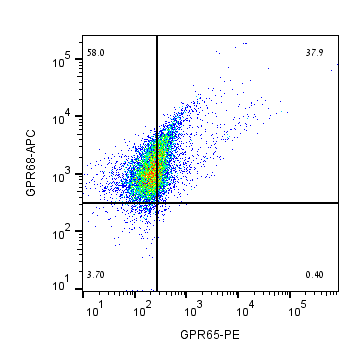Overview
- Peptide (C)HRV(S)FEHYPIQAWQR, corresponding to amino acid residues 169-183 of mouse GPR68 (Accession Q8BFQ3). 2nd extracellular loop

 Cell surface detection of GPR68 by direct flow cytometry in live intact mouse J774 macrophage cells:___ Cells.
Cell surface detection of GPR68 by direct flow cytometry in live intact mouse J774 macrophage cells:___ Cells.
___ Cells + Rabbit IgG Isotype control-APC (#RIC-001-APC).
___ Cells + Anti-GPR68 (OGR1) (extracellular)-APC Antibody (#AGR-042-APC), (5 µg). Cell surface detection of GPR68 by direct flow cytometry in live intact human THP-1 monocytic leukemia cells:___ Cells.
Cell surface detection of GPR68 by direct flow cytometry in live intact human THP-1 monocytic leukemia cells:___ Cells.
___ Cells + Rabbit IgG Isotype control-APC (#RIC-001-APC).
___ Cells + Anti-GPR68 (OGR1) (extracellular)-APC Antibody (#AGR-042-APC), (5 µg). Multicolor flow cytometry with GPR68 and GPR132Human THP-1 monocytic leukemia cell line was labeled by adding Anti-GPR68 (OGR1) (extracellular)-APC Antibody (#AGR-042-APC), (5µg) and Anti-Human GPR132/G2A (extracellular)-FITC Antibody (#AGR-046-F), (5µg).
Multicolor flow cytometry with GPR68 and GPR132Human THP-1 monocytic leukemia cell line was labeled by adding Anti-GPR68 (OGR1) (extracellular)-APC Antibody (#AGR-042-APC), (5µg) and Anti-Human GPR132/G2A (extracellular)-FITC Antibody (#AGR-046-F), (5µg). Multicolor flow cytometry with GPR68 and GPR65Human THP-1 monocytic leukemia cell line was labeled by adding Anti-GPR68 (OGR1) (extracellular)-APC Antibody (#AGR-042-APC), (5µg) and Anti-GPR65 (TDAG8) (extracellular)-PE Antibody (#AGR-043-PE), (5µg)
Multicolor flow cytometry with GPR68 and GPR65Human THP-1 monocytic leukemia cell line was labeled by adding Anti-GPR68 (OGR1) (extracellular)-APC Antibody (#AGR-042-APC), (5µg) and Anti-GPR65 (TDAG8) (extracellular)-PE Antibody (#AGR-043-PE), (5µg)
- Thompson, M.D. et al. (2005) Crit. Rev. Clin. Lab Sci. 42, 311.
- Xu, Y. and Casey, G. (1996) Genomics. 35, 397.
- Zaslavsky, A. et al. (2006) Biochim. Biophys. Acta. 1761, 1200.
- Mohebbi, N. et al. (2012) Cell. Physiol. Biochem. 29, 313.
All GPCRs, including GPR68, are single peptides possessing seven transmembrane domains with an extracellular N-terminus and an intracellular C-terminus1. GPR68 is expressed in several tissues including the spleen, testis, small bowel, brain, heart, lung and kidneys. It shares strong homology (49-54%) with the human receptor GPR42.
GPR68 is proton sensitive in the pH range of 6.8-7.8 and acts as a proton activated receptor. GPR68 stimulates inositol triphosphate (IP3) formation thereby releasing intracellular calcium and activating the mitogen activated protein kinase/extracellular signal-regulated (ERK) kinase cascade. In addition, GPR68 receptor regulates NHE3 and H+-ATPase, in response to extracellular pH changes in cultured HEK 293 renal cells. This activation requires a cluster of histidine residues in the extracellular domains of the receptor and protein-kinase C (PKC) activation4.
Application key:
Species reactivity key:
Anti-GPR68 (OGR1) (extracellular) Antibody (#AGR-042) is a highly specific antibody directed against an extracellular epitope of the mouse protein. The antibody can be used in western blot and indirect live cell flow cytometry. It has been designed to recognize GPR68 from mouse, rat and human samples.
Anti-GPR68 (OGR1) (extracellular)-APC Antibody (#AGR-042-APC) is directly conjugated to Allophycocyanin (APC) fluorophore. This conjugated antibody has been developed to be used in immunofluorescent applications such as direct flow cytometry and live cell imaging.
